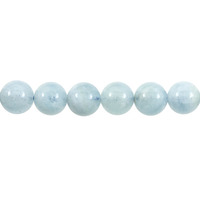Beader’s dictionary
A
AQUAMARINE
Aquamarine is a gemstone of the beryl family. Its name comes from the latin equivalent of sea water, "aqua marina". Its color comes from its iron concentration and includes numerous shades of blue (from pale blue to deep blue and sometimes turquoise). The deep blue aquamarine is the most sought. It is a fragile and shock sensitive gemstone. It is mainly imported from Brazil, Australia, Africa, the United-States, Russia and China. Aquamarine is traditionally associated to the month of October.
G
GEMSTONES (See products)
They used to be known as semi-precious stone, however, this appellation was revoked because it was considered pejorative. Gemstones (also fine gem or gem) are translucent or transparent (topaz, quartz, opal, etc.). The following stones are classified as gems: amber, aquamarine, amethyst, citrine, rock crystal, cordierite, garnet, peridot, tanzanite, topaz, tourmaline and zircon.
There are also ornamental stones such as lapis lazuli and turquoise, which are often mistaken as gemstones. This term generally designates opaque colored stones or stones of a lesser value.
The reconstituted stones are manufactured by a process that reduces useless stones to a powder, the powder is then mixed with glue. Thus making a complete stone. Dyes can be added to give a certain uniformity to the stone's appearance.
The term stabilized means that a natural stone, such as turquoise, was too porous and has been dipped in a resin bath, or into another protective lacquer, to solidify.
In France, the only stones said to be precious are diamonds, sapphires, emeralds and rubies. Around the world, this term refers to any gem of great value.
H
HOWLITE (See products)
Howlite is an opaque white colored stone, at times veined with brown or black. This stone can be easily dyed because of its porosity and its neutral color.
A little bit of history: This stone was discovered in Nova-Scotia in 1868, by canadian chemist Henry How, after whom it was named.
M
MAGNESITE (See products)
Magnesite is a stone that can be white, yellow to brown or at times color-free. It is transparent to translucent. However, on the market a similar stone is available albeit opaque, it is also called magnesite. It can be dyed in any color and often is often made to resemble the turquoise and even the lapis-lazuli.
T
TURQUOISE
Turquoise is an ornamental stone of an opaque blue-green, sky blue and apple green color. It is a phosphate hydrated with copper and aluminum. Its blue tones are attributed to the presence of copper, while its shades of green are relevant to the presence of iron. Its name means "stone of Turkey", as it initially transited for commerce through Turkey at the time of the Crusades. This is where the turquoise stone (in its shade of blue) takes its name. The designation “turquoise matrix” is given to turquoise stones streaked with brown, gray or black veins. Turquoise is often cut into cabochons, beads or carved to make statues or decorative objects.
Turquoise has been mined for a very long time, and a number of deposits are now exhausted. It has been extracted from Iran for at least 2000 years. There is also turquoise jewelry found in Egypt (first dynasty of pharaohs) issued from deposits in Sinai. The said deposits were exploited 4000 BC and are now exhausted. It is now issued from Iran, Afghanistan, Argentina, Australia, Brazil, the United States, China, Mexico, Israel and Tanzania (amongst others).
Sometimes the turquoise can tarnish or change color due to exposure to light, perspiration, oils, cosmetics or loss of its natural moisture. It it is then said to be "dead."
The porous turquoises are stabilized, in other words, they are covered with resin, wax or plastic to be consolidated. Their color can be improved using dyes, copper salts, oil or paraffin.
A reconstituted turquoise can be made of the stone powder agglomerated with a black plastic design and as such, it mimics the "turquoise matrix" with its brown to black veining.
Magnesite, chalcedony and howlite can easily be colored blue to replicates turquoises. There are also many imitations: turquenite, neolite, Viennese turquoise, glass, plastic, porcelain, etc.
Z
ZODIAC STONES
During Antiquity as well as Middle-Ages, it was believed that the formation of gems was influenced by constellations, some gems were as bright as stars. They were thought to be the mirrors of the cosmos. Therefore each planet was associated with one or more gems that possess “magical” properties. These beliefs still circulate in todays modern society, even though there are no tangible proof to support them.
| Sign | Stones |
|---|---|
| ARIES | Carnelian, red jasper |
| TAURUS | Carnelian, pink quartz |
| GEMINI | Citrine, tiger's eye |
| CANCER | Chrysoprase, aventurine |
| LEO | Rock crystal, golden quartz |
| VIRGO | Citrine, yellow agate |
| LIBRA | Orange citrine, smoked quartz |
| SCORPIO | Blood red Carnelian |
| SAGITTARIUS | Sapphire, chalcedony |
| CAPRICORN | Onyx, rutilated quartz |
| AQUARIUS | Turquoise, falcon eye |
| PISCES | Amethyst, quartz amethyst |













